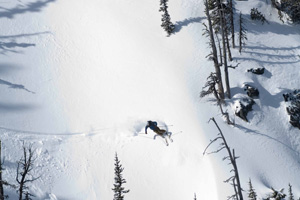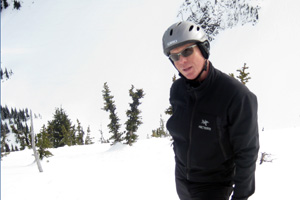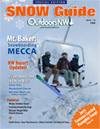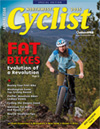SnowSports: Quest for Vertical

Some skiers go for broke on big days
By John K. Nelson
Photo at right: Crystal Mountain’s total vertical drop is 3,100 feet. Photo courtesy of Crystal Mountain.
For most skiers, a day in the mountains is its own reward.
But for some, there’s an added bonus in racking up vertical feet on the slopes and then painstakingly tracking it. These vertical devotees count their totals using an array of high and low-tech devices, then keep elaborate records to relive their experiences later.
“I have the ultimate goal of skiing one million vertical feet in a year,” says Aaron MacMillin, who lives near Northgate in north Seattle. MacMillin skis primarily at Alpental and Crystal mountains and keeps a 28-column spreadsheet documenting his days on the slopes.
“It’s an obsession, but at least it’s a healthy obsession,” he claims. MacMillin tracks his vertical using an altimeter watch. Once he’s home, he records the totals onto the spreadsheet, even going so far as to break down his cost per run.
“My goal every day is to ski at least 20,000 vertical feet,” he says. When he and his ski partners get close to that total, they might feel like quitting, but don’t. “It inspires us to ski a couple more runs.”
Eric Martin, a skier from West Seattle, understands that motivation. He tracks his vertical using an app on his iPhone and often finds himself pushing for a couple thousand more feet, much like a gym rat does watching the mile totals on a treadmill.
“It’s one more way to look at what kind of workout you’re getting,” says Martin, who skis at Crystal Mountain.
Some skiers go for broke on big days.
“My record is 50,000 (vertical feet) in a day,” says Ron Olness of Black Diamond, Wash., another Crystal Mountain skier. “I wanted to see how much I could get, so I skipped lunch and kept skiing.”
While 50,000 vertical feet is a big number, it’s far below the world record. The top mark for most vertical in 24 hours is 340,462 feet, set in 2011 by an Italian skier, according to Guinness World Records. The world record for vertical in a calendar year was set in 1994 by a British skier — 4,146,890 vertical feet.
For Erik Henne, who lives in the Wallingford neighborhood of Seattle, last year’s daily record was 39,280 vertical feet, set on March 14 at Crystal Mountain on a powder day.
“I played hooky today and skied my little heart out,” he recalled in the journal portion of the complicated spreadsheet he uses.
Henne also often skis in the backcountry, where totals are understandably much smaller because he must climb for his vertical. His biggest day in the backcountry last year was 6,470 vertical feet.
“I like quality,” Henne says. He goes where the snow is best.
“If it’s dumping, I’ll go for a day at a lift-served area.” And if it hasn’t snowed in a while, he’ll head for powder in the backcountry.
For Silas Wild, a Seattle resident who skis year-round in the backcountry, the motivation isn’t to rack up big numbers. It’s to keep records to remember what was good at a particular time of year.
“For me, it’s something handy to remind myself where I skied last June,” he says.
All of this record-keeping might seem a little puzzling for some people. Why go to all of that trouble? David Kratsch, senior instructor for the REI Outdoor School in Seattle, says the type of person who tracks vertical is detail-oriented.
“It’s for somebody who wants to take something home from the mountain with them,” Kratsch says. “It tends to be engineers and doctors — people who like to see their progress.”
Companies that guide skiers into the backcountry make sure their clients get ample vertical for the money. Cascade Powder Cats, which operates near Stevens Pass, averages 10,000 vertical feet a day for its clients.
“An incredible day of backcountry skiing is 10,000 feet of vertical,” owner Ryan Murray says. “The most we ever skied was just under 15,000. It was an epic day.”
Another backcountry service, North Cascade Heli near Mazama, Wash., guarantees clients 12,000 to 14,000 vertical feet in a day, says company spokesman Dave Betts.
Maybe you don’t have a guide keeping track of your vertical. Maybe you don’t even have a smart phone app, a GPS or an altimeter watch. How do you track your own vertical?
If you’re skiing at a lift area, you can use this method: find out the vertical drop of each chairlift you ski and keep track of how many runs you take on each.
That was my method last season. At the start of the year, I decided to keep a running total of my year’s vertical. I set the arbitrary goal of getting at least 500,000 vertical feet for the year. Then I went to Crystal Mountain, where I had a season pass, and started skiing.
Did I make it? After 32 days on the slopes, my total for the year was 870,000 vertical feet. It was a great year.
This year, I’m wondering: Can I get to one million?
John Nelson is a former journalist, having worked at several metropolitan newspapers including the Seattle Post-Intelligencer. He now teaches first-grade students at The Meridian School in the Wallingford neighborhood of Seattle.
Best ways to track your vertical quests
Tracking your vertical has never been easier, thanks to an ever-growing array of altimeter watches, smart phone apps and GPS receivers.
If you’re simply tracking vertical at a ski area, it makes sense to keep it simple. You don’t need a complicated GPS receiver—an altimeter watch or smart phone app will do the trick.
David Kratsch, senior instructor for the REI Outdoor School in Seattle, recommends altimeter watches.
“The more technical things get, the bigger the chance for failure,” he says. The problem with GPS receivers, Kratsch adds, is that weather and physical obstructions can hinder reception. In addition, satellite signals used by GPS receivers are sometimes spotty.
Altimeter watches
 Suunto (www.suunto.com/us/en/products/sports-watches-and-instruments), Highgear (www.highgear.com) and Casio (www.casio.com/products/Watches/Sports) are three of the leading companies making altimeter watches. The watches work by using barometric sensors that measure air pressure at a given elevation.
Suunto (www.suunto.com/us/en/products/sports-watches-and-instruments), Highgear (www.highgear.com) and Casio (www.casio.com/products/Watches/Sports) are three of the leading companies making altimeter watches. The watches work by using barometric sensors that measure air pressure at a given elevation.
Because air pressure is constantly changing, they require regular calibration to a known elevation. For instance, if you know the base elevation at a ski area is 4,000 feet above sea level, you should calibrate your watch upon arrival. Once set, altimeter watches can be very accurate—even more accurate than a GPS receiver.
Prices range from $60 – $1,000.
Smart phone apps
Some skiers use apps to track their vertical. One of the most popular is Ski Tracks (itunes.apple.com/us/app/ski-tracks-gps-track-recorder) which works on the iPhone.
“It’s the best I’ve found,” says Ron Olness, a Black Diamond, Wash. skier who regularly tracks his vertical at Crystal Mountain.
Some of the best known apps for ski tracking include:
Ski Tracks, Ski-o-meter (itunes.apple.com/be/app/ski-o-meter) and Elevation Pro (itunes.apple.com/us/app/elevation-pro) are available for the iPhone;
Satski (satsportsgps.com/satski) works on the iPhone, Android and Windows phones;
Ripxx (itunes.apple.com/app/ripxx-ski-and-snowboard/id393136563?mt=8) is available for iPhone and Android;
Phresheez (phresheez.com) also is multi-platform, working on Android, Blackberry, Garmin and Magellan devices;
Android-only apps include Google Map My Tracks (www.mapmytracks.com ), Ski Eagle (www.androidapps.com/sports/apps/326523-ski-eagle-gps-sionc) and Compowdre (compowdre.com).
GPS receivers
Many backcountry skiers are sold on GPS receivers because of the mapping capabilities. Prices range from $150 – $455. Top manufacturers for GPS receivers are Garmin (www.garmin.com), Magellan (www.magellangps.com) and Delorme (delorme.com).
~John K. Nelson




